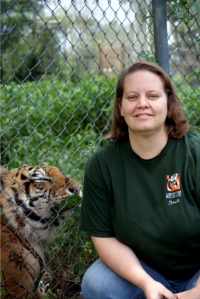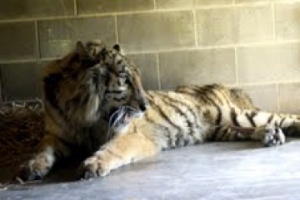In Episode 28 of On the Road with Mac and Molly, I chat with Kathryn Bertok, Curator of Animals at the Carolina Tiger Rescue. The organization, formerly known as the Carnivore Preservation Trust, is a 501(c)3 nonprofit wildlife sanctuary whose mission is saving and protecting wild cats in captivity and in the wild.
In this program, Kathryn and I touch on all things tiger, discussing everything from chuffling (tiger speak) to mother-cub interactions to the tiger’s affinity for water (not only for drinking but for bathing). We review how tigers are faring in the wild and what happens to an ecosystem when a top-of-the-food-chain predator is diminished or removed.
We discuss the $15 billion exotic pet trade (only drugs and weapons are bigger moneymakers on the black market) and we expose the use and abuse of exotic animals for the entertainment of human beings. Most heartbreaking of the stories shared by Kathryn is one involving tiger cubs that are used for photo opportunities in petting zoos; once these animals pass the cute and cuddly stage (after they're only about three months of age), they may be euthanized, end up in canned hunts, or be sold as "pets."
Kathryn and I lament how little there is in the way of laws in the U.S. regulating the sale and purchase of exotic animals. The health and safety of not only the animals but human beings as well are put at increased risk through this lack of oversight.
Just a few days ago, Noah Barthe, 4, and his six-year-old brother Connor were killed (strangled to death) by a 100-pound African rock python after it escaped from an enclosure inside a friend's apartment in Campbellton, New Brunswick, Canada. Authorities believe the snake escaped from its tank, slithered through a ventilation system and fell through the ceiling into the room where the two boys were sleeping. The snake has been euthanized and the Canadian government is now considering what it should be doing to help ensure something like this never happens again. The CBC reports that the coroner who presided over a snake death inquest in Ontario two decades ago bewails that nothing was learned from that earlier tragedy. "Dr. David Evans says the inquest called for changes to municipal, provincial and federal rules regarding exotic pets, but none of the jury's five recommendations was implemented, including the suggestion for an exotic pet registry." Perhaps now, following these most recent deaths, greater protections will be put into place in Canada. And, perhaps, the United States will follow suit.
In the U.S., you could have a lion or tiger--or a 100-pound python--living next door to you and there may well be no laws in your area requiring your neighbor to make you aware of that fact. (For more information on the U.S. laws regarding exotic pets, see "Saving Aria: Finding Sanctuary at Carolina Tiger Rescue" at http://www.rubberhobos.com.)
Kathryn and I conclude our time together with the story of Aria, a tiger who was confiscated from her "owner" after she was determined to be desperately ill. Carolina Tiger staff traveled down to South Carolina to collect her. She weighed only 200 pounds (a healthy female should weigh closer to 360), was suffering from diarrhea, and had no muscle mass and no fat coverage on her ribs. The staff had difficulty getting a heart rate. Kathryn said, "I have no doubt the man [who'd kept her as a pet] loved this cat and had tried to care for her . . . [Nevertheless] in my fourteen years [with Carolina Tiger] this is by far the worst condition in which I’ve ever seen a rescued animal arrive.”
Aria was placed in thirty-day quarantine at the sanctuary and run through a battery of medical checks. She was started on anti-diarrheal medications, Pepcid, and antibiotics and, as she wasn’t eating, an appetite stimulant. “You can’t force-feed a tiger,” Kathryn noted. “The first day, we weren’t sure she’d survive. Then she started to eat a little and became more active.”
Bloodwork revealed a pancreatic insufficiency so the staff started feeding her beef pancreas, the enzymes from which worked to break down the food she was eating so it could be digested. The enzymes were powerful enough to eat through the latex gloves of the individual handling the beef pancreas but they were exactly what the tiger needed to jump start her system. Following other medical treatments, Aria is now making a wonderful recovery.
In addition to Aria, the 55-acre Carolina Tiger Rescue has more than 70 animals in its care at the Pittsboro, North Carolina facility. Along with tigers, binturongs, lions, cougars, bobcats, caracals, kinkajous, ocelots and servals have found sanctuary there.
The organization is working toward the day when “wildcats are not owned by individuals as pets; wildcats are not used for entertainment purposes; no trade exists for wildcats or their parts; and all wildcats prosper in sustainable, native habitats.”
To achieve that mission, Carolina Tiger Rescue:
- rescues wildcats;
- provides lifelong sanctuary for wildcats;
- educates the public about the plight of wildcats in captivity and in the wild;
- conducts non-invasive research to further understand and aid wildcats; and
- advocates for action to maintain wildcats in sustainable native habitats, or--when that is not a viable option--for the respectful, humane treatment of them in captivity.
I hope you'll listen to this program and I hope you'll care enough about the plight of tigers to act on their behalf. There are only 3,200 tigers left in the wild but perhaps as many as 10,000 are kept in captivity in the United States; five thousand of these animals are in Texas. These magnificent cats and other wild animals deserve our respect. Please care. Educate, advocate, volunteer, donate.
Here is a link to a video on Carolina Tiger Rescue and its work in saving Aria:
Here is a link to a video on Carolina Tiger Rescue and its work in saving Aria:
Photographs by Carolina Tiger Rescue.
 |
| Jellybean |


























